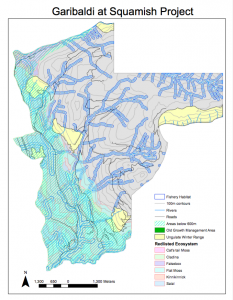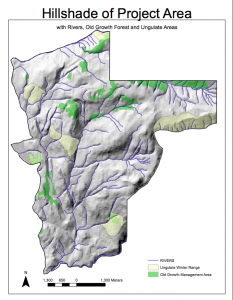Garibaldi at Squamish project is a ongoing project by Northland Properties and Aquilini Investment Group of Vancouver to build a ski resort on the Brohm Ridge in Squamish, BC. Since the initial proposal in 1997, there had been multiple criticisms regarding the project, including from BC Environmental Assessment Office in 2010 and Resort Municipality of Whistler in 2015. As a natural resource planner retained by the company, my job was to provide recommendations of priorities in order to proceed with their proposal. I have created a map of the project area and a hillshade map of the project. In addition, I proposed a memo of summary and recommendations to my client.
Here is the map of the project area:

to view the PDF file of in full resolution, click this link:garibaldi-at-squamish-project
Within the project area, the map includes
- Fishery habitat
- Ungulate winter range
- Old growth management areas
- Red-listed ecosystems
- Areas below 600m
- Roads
- Rivers
- 20 m contours lines
Here is the 3D hillshade of the project area containing rivers and ungulate winter range:

to view the PDF file of in full resolution, click this link: garibaldi-at-squamish-project-hillshade
To view the memo of recommendation to my client, click the link below to view PDF:
When working on environmental projects as a natural resource analyst, there were proposals in the past that I don’t necessarily ethically believe in. Although I might not believe certain projects are ethical, they should still continue after in depth cost and benefit analysis since “ethical” is still subjective. There are many factors that affect the ethics of a project. For instance, there are issues relating to the environment (animal habitat, water, natural resources), social (how is the project in impacting the people), and what are the potential consequences. Depending on the project, the extend to which it affects all the above areas are different as well. Some projects may affect animals more, and some might affect the people more. Under such differences, as long as there are distinctively outlined consequences and active ways of mitigating the consequences, the project should still continue. Since it is only my personal opinion and evaluation about if the project is ethical, there might be other factors and benefit that I did not see. For example, an unethical project may bring social or economic growth to a region in ways that no other developments can. In that case, if the project is benefiting and changing the society as a whole, it should continue. There is always going to be cost to every project, sometimes the result exceed the cost. Therefore as long as there are careful consideration and planning, a project should continue regardless if I, personally, think if it is ethical or not.
The above suggestion is not completely different from my memo. Since I have been hired by Northland Properties and Aquilini Investment Group of Vancouver as a natural resource planner, my job is to analyze and provide feedback against criticism being made on the project. Although my memo is slightly biased towards the proposal company, the overall goal should still be providing recommandations instead of persuading them from continue or halt the project. In the memo, I also clearly outlined what I thought was two of the biggest concerns of the project and provided solutions to alleviate the effect. Thus, it is still up to the company to decided whether they should continue or stop the project. After all, the project is predicted to entice economic growth such as provide job opportunities.